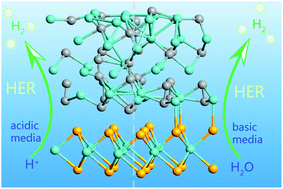High-performance hydrogen evolution at a MoSe2–Mo2C seamless heterojunction enabled by efficient charge transfer†
Abstract
Transition metal dichalcogenides (TMDs), such as molybdenum diselenide (MoSe2), have poor alkaline hydrogen evolution activities due to their unfavorable hydrogen adsorption and dissociation properties. In this work, we report a Mo2C/MoSe2 hybrid catalyst seamlessly grown on Mo foil. The Mo2C/MoSe2/Mo electrode exhibits outstanding activity for the hydrogen evolution reaction (HER) with a low overpotential of 51 mV at 10 mA cm−2 in 1 M KOH, significantly outperforming the performances of its MoSe2 and Mo2C counterparts and most reported TMD electrocatalysts in alkaline solution. Moreover, the Mo2C/MoSe2/Mo electrode also possesses good catalytic HER performance in acid. Density functional theory (DFT) calculations reveal that metal-induced gap states formed in the interface region of Mo2C and MoSe2 can make the interfacial semiconducting MoSe2 transform into metallic MoSe2. The transformation is beneficial to speeding up charge transfer between the interfaces, promoting H atom adsorption and desorption kinetics, and therefore enhancing the catalytic performance.



 Please wait while we load your content...
Please wait while we load your content...